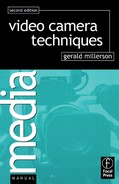There is a great diversity of musical instruments, from piccolo to grand organ, from harp to percussion. Each offers a very specific range of interesting, meaningful shots. Some instruments are best seen in a wider shot, where both hands (and feet!) are busy with intricate action. In others the center of attention is comparatively localized, and only shown effectively in close shots.
Instrumentalists in a seated group tend to move very little, but solo performers frequently sway about as they play. Some violinists for instance, turn to such an extent that a single camera may not be able to sustain close shots of the fingerboard. Instead, the director has to alternate between several different viewpoints.
Shooting techniques should obviously suit the form of the musical performance. In rock concerts, off-the-cuff shots are intended for effect rather than to impart information. They convey the spontaneous spirit of the occasion. For more formal music, shots need to be selected carefully if they are to display techniques clearly.
For orchestras and bands, camera treatment usually consists of:
• Wide shots of the entire orchestra.
• Group shots (sections).
• Shots of individual soloists.
• Detail close-ups of fingerwork.
Because large groups of musicians are spread over an appreciable area, cameras will normally be some distance from their subjects. So one has to use narrow lens angles for close shots, even if the resulting foreshortening is very noticeable.
Some directors favor continual camera movement between a variety of positions. Others prefer to intercut or mix between fixed positions.
Shot organization is important, otherwise there is every chance that a camera will arrive at an instrument just as its player has finished a passage, and is taking a dozen bars rest! Knowing the musical arrangement, and having a good memory for shots certainly helps. Although the director is probably following a score, a lot depends on individual camera operators’ alertness.
As we saw earlier, there is always the temptation to take shots that are ‘different’ or ‘dramatic’: low viewpoints, reflections, floor shadows, rhythmical feet, and that old routine of focusing from harp strings through to the players beyond. Great ideas perhaps for suitable occasions – but make sure that they are appropriate!
Shooting the violinist
The shape of any instrument, and how it is played, determines which angles provide the best shots.

